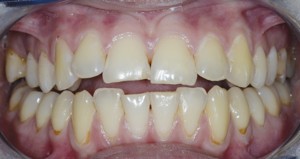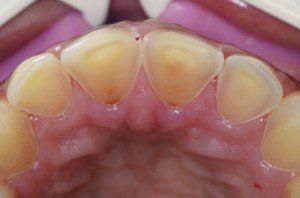This article has the following learning objectives:
1
Describe the oral, psychological and systemic complications of eating disorders
2
Recognise the warning signs of eating disorders
3
Describe an evidencebased dental care and support protocol for patients with eating disorders
4
Increased awareness of resources for individuals with eating disorders.
Several years ago, a concerned patient confided in me that her teenaged daughter was recovering from an eating disorder, and she asked me to be vigilant for oral signs of relapse. Of course I readily agreed; as a dental hygienist, I was in an ideal position to detect oral signs of eating disorders. On reflection, however, I found that my knowledge of these signs was limited, and according to the 2005 research by DeBate, Tedesco and Kerschbaum,1 I was not alone in this predicament. I was aware of one classic sign – dental erosion related to the purging by vomiting seen in bulimia – and I could recognise some oral signs of malnutrition, but soon realised there were gaps in my knowledge.

Credit: © KatarzynaBialasiewicz/iStockphoto/Thinkstock
I was also uncomfortable with broaching this sensitive topic with a patient if an eating disorder was suspected. However, I understood my ethical obligation to increase my knowledge and participate in secondary prevention of eating disorders, as it could improve prognosis and even be a life-saver: eating disorders have the highest mortality rate of all psychiatric illnesses.2
My mission was to improve the care and support for my young patient, and others who might need it, by acquiring further knowledge of the oral and systemic signs of eating disorders. I needed the capability to initiate timely interventions, and minimise damage to the oral hard and soft tissues. It was also necessary to be able to instigate medical referral, in order to facilitate referral to therapists specialising in treating eating disorders.

Credit: © Artfoliophoto/iStockphoto/Thinkstock
An overview of eating disorders
Eating disorders are psychiatric illnesses characterised by disordered eating, and disturbed attitudes to eating and body image; they are often accompanied by inappropriate, dangerous methods of weight control. The three most common eating disorders are bulimia nervosa, (binge-purge), anorexia nervosa, (starvation) and binge-eating disorder (bingeing without purging).3

Credit: Severe dental erosion related to bulimic purging. Produced with permission from Dr S. Weinstein


Credit: Erosive and abrasive lesions on the teeth of a 35-year-old woman with anorexia and bulimia (from BDJ 2014; 216: 463–468)

Credit: Initial cervical erosive lesions in a young patient with anorexia (from BDJ 2014; 216: 463–468)

Credit: Reflux from vomiting led to acidic dissolution of the lingual side of the maxillary incisors in this patient (from BDJ 2014; 216: 463-468)

Credit: A bizarre palatal haematoma in a 30-year-old female bulimic (from BDJ 1999; 186: 109–113)
There are variations of disordered eating, and eating disorders not otherwise specified (EDNOS).4 These include diabulimia,5 where individuals intentionally take insufficient insulin in order to lose weight; anorexia athletica, which is obsessive, excessive exercising to the point where it becomes detrimental to health; bigorexia, or muscle dysmorphia; orthorexia nervosa, an obsession with the quantity and quality of the food consumed; night eating syndrome, the compulsive, excessive intake of food during the hours normally reserved for sleep – often getting up multiple times during the night to eat; pica, the persistent eating of non-food substances, and various food phobias.
Prevalence of eating disorders
According to a 2002 survey, 1.5% of Canadian women aged 15–24 years had an eating disorder.6 The UK has the highest rate of eating disorders in Europe: recent figures suggest that one in 100 British women has a clinically diagnosed eating disorder.7 In the USA, anorexia nervosa is the third most common chronic illness among adolescents.8 Eating disorders occur mostly in females aged 15–25 years of age, but also occur in males, in children as young as seven, and in people aged over 50.
Bulimia nervosa is the most common eating disorder and is characterised by a pattern of consumption of massive amounts of food (binge-eating) and recurrent inappropriate behaviours to control one’s weight. These include purging through self-induced vomiting, abuse of laxatives, diuretics, or emetics, or other behaviours such as fasting (not eating for at least 24 hours) or excessive exercise. The weight of bulimic individuals tends to fluctuate, but is usually within normal limits. About one third of bulimics have a history of anorexia nervosa, and some have a history of obesity.
During bingeing, bulimic individuals usually consume between 1,500 to 3,000 calories within one or two hours, but have been known to consume as much as 60,000 calories in one bulimic binge. They typically eat sweet, high-calorie foods which are easy to consume quickly, like ice cream. This is followed by depression, panic and guilt, and a compulsion to purge. These episodes occur at least twice weekly over a period of several months; some bulimic individuals vomit five or six times per day. Most bulimics who die do so in the act of purging. According to the National Institute of Dental and Craniofacial Research in the US, 28% of patients with bulimia are first diagnosed during a dental appointment.
Anorexia nervosa is marked by four main features:
A refusal to eat enough to maintain body weight within 15% of the minimally normal weight for age and height: the anorectic individual is often 20% to 40% below a healthy body weight
An extreme fear of gaining weight
A distorted body image: thinking they are fat, even when they are emaciated
Amenorrhoea (absence of menstruation).
A significant number of anorectic individuals also purge, and some have pica; for example, consuming cotton balls soaked in orange juice to control hunger. The main difference between bulimia nervosa and purging anorexia is that the individual with anorexia is underweight.
This is characterised by frequent consumption of abnormally large amounts of food in one sitting, while feeling a loss of control over their eating. Individuals with this disorder do not purge afterwards, but feel depressed and guilty after overeating. Most individuals with binge-eating disorder are obese, with the related increased risks of diabetes, heart disease, certain cancers, and arthritis.
The aetiology of eating disorders is multifactorial, and not completely understood: contributing factors include a culture where thinness is admired. There are unrealistic depictions of beauty and thinness in the media; at about 6 feet tall and 117 pounds, today’s fashion model weighs 23% less than the average woman. Some over-achieving perfectionists who do not fit this questionable ideal develop eating disorders: they have low self-esteem, a distorted perception of body shape, and a poor body image.9
The risk of a female developing anorexia nervosa increases 10-20 times if she has a sibling with the disorder. Eating disorders often occur in individuals who have suffered physical or psychological trauma,10 and are frequently accompanied by other psychiatric illnesses11 such as depression, anxiety,12 self-harm (such as cutting), obsessive-compulsive disorder, and chemical dependency.
The medical complications of eating disorders are shown in Table 1 and the psychological aspects of eating disorders in Table 2.
Table 1 Medical complications of eating disorders13,14Table 2 Psychological aspects of eating disorders17
Traumatic lesions on the palate and oropharynx are caused by insertion of objects to induce vomiting. Signs of nutritional deficiencies occur, such as angular cheilitis, candidiasis, glossitis, and oral mucosal ulceration. Individuals with eating disorders also experience a dry mouth related to dehydration, or xerogenic medications such as antidepressants, and anxiolytics. They have a high caries risk related to dry mouth and impaired salivary buffering capacity, and bulimics tend to consume foods high in refined carbohydrates. In addition, individuals with eating disorders often consume acidic drinks like citrus juices and carbonated diet drinks.
Dental erosion occurs due to purging by vomiting18 and becomes apparent about six months after onset. Vomit has a pH of about 3.8; during purging, the vomit hits the palatal aspects of the maxillary anterior teeth. This erosion eventually undermines the palatal surfaces and leads to incisal fractures and chipping, and overeruption of the mandibular teeth. Erosion also occurs in the posterior teeth, causing perimylolysis – the tooth tissue surrounding restorations is eroded, leaving the restorations with a raised, island-like appearance. Eroded occlusal contacts also lead to loss of vertical dimension. Dental hypersensitivity is also common, and loss of bone density increases the risk of jaw fracture during extractions.
Medical treatment of eating disorders often includes nutritional therapy to address the medical complications, and also the starvation-related brain changes that perpetuate the condition. This is combined with psychotherapy and medication, such as antidepressants.
Dental management of patients with eating disorders
20,
21
These individuals need regular dental visits for continuing care and support, and we should provide an environment in which the patient feels comfortable. Patients with eating disorders must be regarded as medically compromised, due to the risk of grave medical complications, particularly cardiac arrhythmias or cardiac arrest due to electrolyte imbalance.
Thorough clinical assessment
General appraisal begins as soon as we greet our patient. We should be tactfully observant of their general demeanor, gait, and facial symmetry; the skin should also be observed for lesions and pallor, and the hands for Russell’s sign, or nail clubbing (for an example, see http://commons.wikimedia.org/wiki/File:Clubbing2.JPG).

Credit: Callus on the back of the hand (Russell’s sign) in a 37-year-old male with a history of bulimia nervosa of 20 years’ duration (from BDJ 1999; 186: 109–113)

Credit: An example of bilateral parotid enlargement; this is episodic (from BDJ 1999; 186: 109–113)
A comprehensive medical history is needed, and monitoring of the blood pressure and the pulse.
Extra-oral examination and intra-oral examination of the oral hard and soft tissues is needed, plus comprehensive documentation that includes detailed clinical notes, periodontal charting, radiographs, intraoral photographs and study models to monitor damage.
When an eating disorder is suspected, this sensitive topic needs to be broached in a non-judgmental, non-threatening manner. It is beyond our scope of practice to diagnose eating disorders, but we can present the findings of our examination to the patient.22 For example, if there is dental erosion, mention some possible causes: acidic drinks, acid reflux or frequent vomiting. This gives the patient an opportunity for disclosure. If they disclose their eating disorder to us, they should be referred to their physician; if they are not ready to tell us, we can still be supportive and initiate a prevention protocol based on our clinical findings.
Definitive dental restorations such as crowns cannot be completed while a patient is purging regularly, as acid erosion will shorten the life of the restorations. Only essential restorative work should be done, sufficient to limit tooth damage and keep the patient free of pain. Pending recovery from their eating disorder, the dental hygienist can provide interventions to limit damage to the oral hard and soft tissues, and relieve xerostomia and dental hypersensitivity.
During dental hygiene appointments, polish with a non-abrasive fluoride paste. A protocol to reduce caries risk should include in-office fluoride varnish applications, plus self-applied neutral fluoride, and calcium and phosphate products such as Novamin, Recaldent, or nano-hydroxyapatite, to promote remineralisation and relieve dental hypersensitivity.
Xylitol products are also beneficial. When used for five minutes, five times per day, xylitol stimulates salivary flow, reduces the oral population of cariogenic bacteria, and reduces oral acidity. There are toothpastes, gum and candies containing xylitol. The patient should brush three times per day with a soft brush, and a toothpaste containing 5000 ppm fluoride. They need to clean interproximally daily, and also clean their tongue, to remove biofilm and acid residue.
A mouthguard can be used to protect the dentition during vomiting. The patient should not brush directly after vomiting, as this causes more loss of tooth structure, and rinsing with water will reduce the protective properties of the saliva. Instead, the oral pH should be neutralised by rinsing with one teaspoon of bicarbonate of soda in 8 oz of water, or a product with calcium and phosphate ions. For additional support, as dental hygienists we can also share information about resources for those with eating disorders.23
Eight years after that worried mother took me into her confidence, her daughter is healthy. However, others still battle eating disorders, which are potentially fatal. Armed with increased knowledge and experience, we dental care professionals can be more observant during assessment, and better able to detect the warning signs of eating disorders. This is a crucial aspect of good patient care and improved outcomes for our patients.
The SCOFF questionnaire (Table 3) uses an acronym in a simple five question test devised for use by non-professionals to assess the possible presence of an eating disorder. It was devised by Morgan et al. in 1999: Morgan J F, Reid F, Lacey J H. The SCOFF questionnaire: assessment of a new screening tool for eating disorders. BMJ 1999; 319: 1467-1468. Available at: http://www.bmj.com/content/319/7223/1467 (accessed January 2015).
Table 3 The SCOFF questions* (from BMJ 1999; 319: 1467–1468)
Online Eating Disorder Screening
http://www.nationaleatingdisorders.org/online-eating-disorder-screening
NHS Choices. Eating disorders: advice for parents. http://www.nhs.uk/Livewell/eatingdisorders/Pages/eating-disordersadvice-parents.aspx
Central and North West London NHS Foundation Trust. Vincent Square Eating Disorder Service. http://www.cnwl.nhs.uk/vincent-square/further-information-resources/outside-support/anorexia & bulimia care. Information and statistics. http://www.anorexiabulimiacare.org.uk/information-and-statistics-media
One hour of non-verifiable (general) CPD
1
Eating disorders:
A
have the highest mortality rate of all psychiatric illnesses
B
are often accompanied by other psychiatric illnesses such as depression, anxiety, self-harm and chemical dependency
C
often occur in individuals who have suffered physical or psychological trauma
D
all of the above
2
Repeated vomiting typically causes erosion of the:
A
palatal aspects of the maxillary anterior teeth
B
lingual aspects of the mandibular anterior teeth
C
distal surfaces of the second or third molars
D
facial aspects of the entire dentition
3
Russell’s sign is found in bulimic individuals, on the:
A
palate
B
knuckles of the dominant hand
C
around the eyes
D
corners of the mouth
4
Why should individuals with eating disorders such as anorexia nervosa or bulimia nervosa be regarded as medically compromised during their dental appointments?
A
malnutrition, dehydration, and loss of electrolytes raise the risk of cardiac arrhythmias
B
they are at risk for osteoporosis, and jaw fracture during extractions
C
they are at risk for gastric bleeding
D
all of the above
The correct answers will be published in the February online issue of BDJ Team

